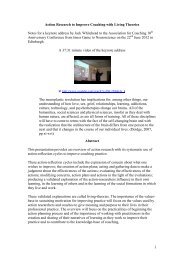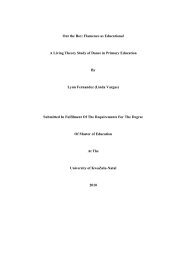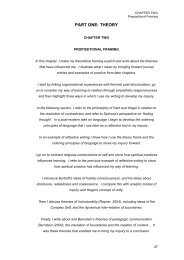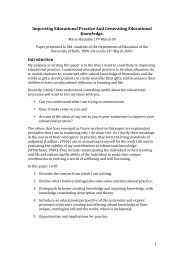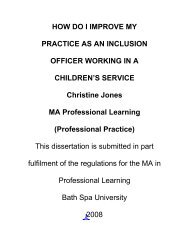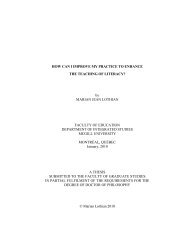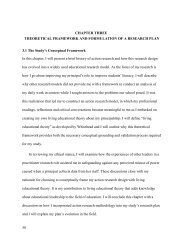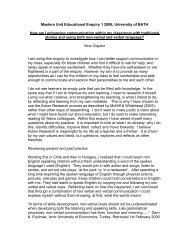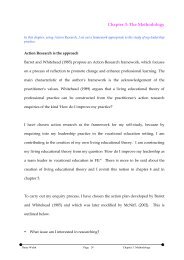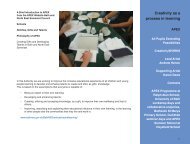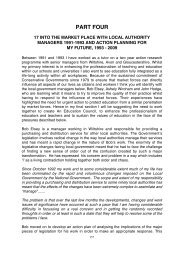Action research transcends constraints of poverty in elementary ...
Action research transcends constraints of poverty in elementary ...
Action research transcends constraints of poverty in elementary ...
Create successful ePaper yourself
Turn your PDF publications into a flip-book with our unique Google optimized e-Paper software.
through the process <strong>of</strong> engag<strong>in</strong>g students <strong>in</strong> action <strong>research</strong>:1. Claim: By <strong>in</strong>tentionally ask<strong>in</strong>g my students to give me feedback andus<strong>in</strong>g this feedback for action <strong>research</strong>, I am able to change my teach<strong>in</strong>gpractices to transcend the <strong>constra<strong>in</strong>ts</strong> <strong>of</strong> moral <strong>poverty</strong> and create anauthentic, democratic co-learn<strong>in</strong>g environment.Indicators: teacher and students as co-learners (learn<strong>in</strong>g from and witheach other), feedback and action cycle between student and teacher andvice versa, evidence <strong>of</strong> changes made to teach<strong>in</strong>g practice which honourstudent voice and student embodied knowledge.2. Model<strong>in</strong>g the action-<strong>research</strong> process by <strong>in</strong>vit<strong>in</strong>g criticism <strong>of</strong> my ownteach<strong>in</strong>g practice and act<strong>in</strong>g on the feedback I received proved to be aneffective way to lead <strong>in</strong>to student-directed action <strong>research</strong> projects whichaddress issues <strong>of</strong> moral <strong>poverty</strong>.Indicators: teacher recognises the need to let student’s voice their ownquestions, students voice their own questions <strong>in</strong> the form, “How can Iimprove my learn<strong>in</strong>g?”, questionsPraxisACTION 1-4: Research<strong>in</strong>g and act<strong>in</strong>g on student attitudes towardsmathIn the follow<strong>in</strong>g video I describe the activity I did with my studentswhich was <strong>in</strong>spired by the title <strong>of</strong> a chapter <strong>in</strong> a book by Judy Willis(2010) entitled Learn<strong>in</strong>g to Love Math. The chapter title is, “Revers<strong>in</strong>gmath negativity with an attitude makeover”. I decided to do an <strong>in</strong> class,<strong>in</strong>formal survey <strong>of</strong> their attitude towards math. Although I talk <strong>in</strong> thevideo about negative and positive ideas about math, with my students Iwas much more explicit. I expla<strong>in</strong>ed that what I was look<strong>in</strong>g for wereexamples <strong>of</strong> when they f<strong>in</strong>d math enjoyable and they learned as well asexamples <strong>of</strong> barriers that made it difficult for them to enjoy math andlearn. Below I have written the <strong>in</strong>structions I gave students at thebeg<strong>in</strong>n<strong>in</strong>g <strong>of</strong> the class taken from my journal after the event.I am go<strong>in</strong>g to ask you to do a th<strong>in</strong>k –pair–share today aboutmath and what you love or like about math - what helps youlearn math and what does not... I want you guys to focus on theproblem solv<strong>in</strong>g we are do<strong>in</strong>g <strong>in</strong> class. Can you make a chart <strong>in</strong>your notebooks, please (T-Chart with a heart and an X as titles).I am go<strong>in</strong>g to give you some quiet th<strong>in</strong>k<strong>in</strong>g time to th<strong>in</strong>k aboutthe follow<strong>in</strong>g questions:



